Choosing the right curing system for your press is a big decision. It impacts quality, speed, and cost. Traditional UV curing has been the go-to for years. Now, LED UV curing is gaining serious traction. This guide will help you understand the differences. We will focus on label printing and narrow-web presses.
Traditional UV systems use mercury vapor lamps. These lamps emit a broad spectrum of UV light. They require a warm-up period. They also generate significant heat. This heat can be a problem for sensitive substrates. It can also warp anilox rolls. Bulb replacement is another factor. Mercury lamps have a limited lifespan. They need frequent replacement. This adds to operating costs. Disposal of spent bulbs also requires special handling.
The energy consumption of traditional UV is also noteworthy. These lamps draw a lot of power. They need a robust power supply. The heat generated also requires an efficient exhaust system. This further increases energy demands. With traditional UV, you are paying for light you might not need. The broad spectrum can cure inks effectively. However, it can also degrade certain materials. Color shifts can occur over time. This affects print consistency.
Now, let’s talk about LED UV curing systems. These systems use arrays of light-emitting diodes. LEDs emit UV light at specific wavelengths. This is a game-changer. You can match the LED output to your ink chemistry. This leads to more efficient curing. It means faster cure speeds. The energy efficiency is a major advantage. LEDs consume significantly less power than mercury lamps. They reach full intensity instantly. There is no warm-up time needed.
The cool operation of LED UV is another benefit. They produce very little heat. This makes them ideal for heat-sensitive substrates. Think thin films and delicate papers. This opens up new possibilities for label printing. You can print on a wider range of materials. Warping of anilox rolls is also minimized. This preserves the life of your valuable components.
LED UV lamps have a much longer lifespan. They can last tens of thousands of hours. This drastically reduces downtime. It also lowers the cost of consumables. You are not replacing bulbs frequently. The waste generated is also less. This is good for the environment. It’s also good for your bottom line.
Consider the process of flexographic printing. Flexo is popular for labels and packaging. Traditional UV works well with flexo. However, LED UV offers enhanced benefits. Faster curing means faster production speeds. This is critical in the competitive label market. The precise wavelength control ensures consistent ink adhesion. It prevents ink spread. This leads to sharper details and crisper text.
For offset printing, the benefits are similar. Offset presses often run at high speeds. The instant on/off capability of LED UV is advantageous. It allows for spot curing. This is useful for special effects. It also helps prevent ink transfer on the back of the sheet. The reduced heat is also beneficial for offset. It helps maintain sheet flatness.
Narrow-web printing is all about efficiency and precision. This is where LED UV truly shines. The compact nature of LED systems is a plus. They fit easily into existing narrow-web presses. The instant curing allows for immediate downstream processing. This can include die-cutting or slitting. You don’t have to wait for inks to dry. This speeds up the entire production workflow.
The cost of ownership is an important consideration. While the initial investment in LED UV systems might be higher, the long-term savings are substantial. Reduced energy bills, fewer bulb replacements, and lower waste disposal costs all add up. The improved print quality and ability to use a wider range of substrates also contribute to increased profitability.
When evaluating LED UV systems, look at the specific wavelengths offered. Ensure they match your ink formulations. Check the irradiance levels. This refers to the intensity of the UV light. Higher irradiance generally means faster curing. Consider the cooling system of the LED unit. While they run cool, some heat dissipation is still necessary.
Traditional UV has served the industry well. But technology advances. LED UV curing represents a significant leap forward. For label printers and narrow-web operations, the advantages are clear. Increased speed, better quality, and lower operating costs are compelling reasons to make the switch. The environmental benefits are also a strong selling point.
Think about your current production challenges. Are you struggling with substrate limitations? Is heat causing issues on your press? Are bulb replacement costs a concern? If you answered yes to any of these, it’s time to seriously explore LED UV curing. It’s not just a trend; it’s the future of efficient and high-quality printing.
The precise control offered by LED systems is remarkable. It means less wasted ink. It means fewer rejected jobs. The consistency from batch to batch is improved. This builds customer trust. It also reduces costly reprints. The investment in LED UV technology is an investment in your business’s future. It’s about staying competitive. It’s about delivering the best possible product to your clients. The transition to LED UV is becoming increasingly easier and more cost-effective. The technology continues to evolve, offering even greater performance.












